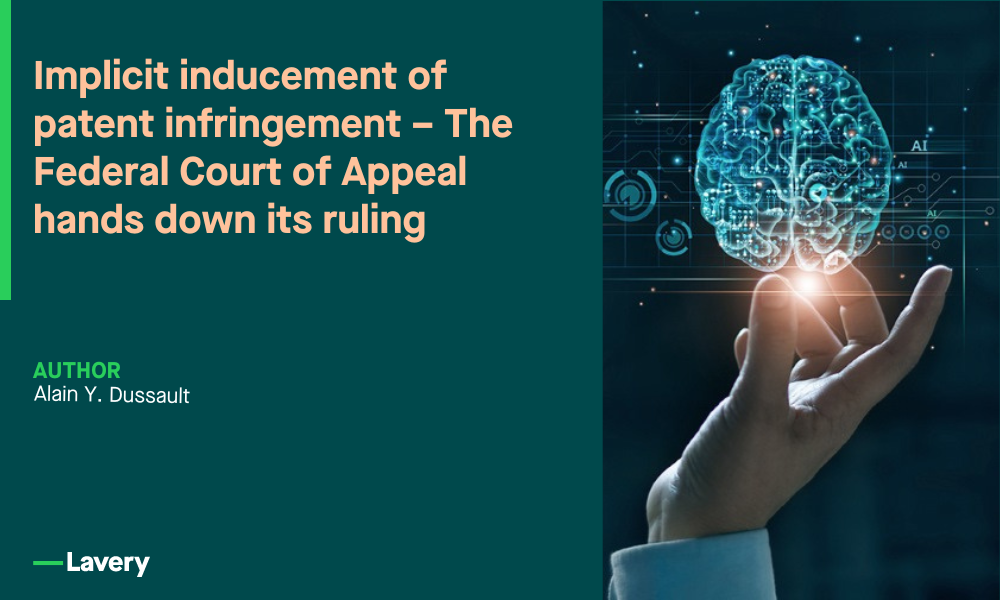Can a patent be infringed even if the patented product is not manufactured, assembled, or even used?
Indeed, such infringement is possible. In fact, this is known as the theory of inducement of infringement. Naturally, acts of “inducement” must meet certain conditions before inducement of infringement can be found. The Federal Court of Appeal recently clarified these conditions.
Inducing infringement and the applicable test
For example, if the patented invention is a solution containing components A, B, and C of a drink where component C is water, it is likely that if components A and B are sold to a consumer and said consumer is told to add a certain amount of water, mix well, and drink, the consumer can be said to have been induced to infringe the patent.
Recent Articles
To determine whether inducement of infringement has occurred, the courts apply a three-prong test.
First, the acts of infringement must have been completed by the direct infringer. In the previous example, this would be the consumer. There can be no inducement of infringement if there has been no direct infringement.
Second, the completion of the acts of infringement must be influenced by the acts of the alleged inducer to the point that, without the influence, direct infringement would not take place (for example, by selling the material and providing instructions).
Third, influence must be knowingly exercised by the inducer; in other words, the inducer knows that this influence will result in the completion of the acts of infringement.
The Federal Court case
Returning to the Court of Appeal’s decision: in this case, Janssen had sued Apotex for inducing infringement of a patent. An important point is that the patent on the drug had expired. However, Janssen claimed that Apotex was inducing physicians to prescribe the drug in combination with a specific inhibitor to treat a rare condition called pulmonary arterial hypertension (PAH). Janssen’s patent covers the combination of the drug and the inhibitor to treat PAH.
Apotex would have sold the drug alone, without including the inhibitor or the combination, had Health Canada authorized its drug. Nowhere in the product monograph is it suggested that the drug be used in combination with the inhibitor in question. However, the drug was being prescribed to treat PAH.
The parties agreed that the first prong of the test had been met, namely that the drug was likely to be prescribed with the inhibitor to treat PAH. It was the second and third prongs that were actually at issue: Could Apotex be inducing infringement even though its product monograph contains no suggestion for use in combination with the inhibitor in question?
The Federal Court had concluded that the second and third prongs of the test for inducing infringement had been met. It ruled that the product monograph sufficiently influenced physicians to prescribe the drug in combination with the inhibitor, and that Apotex knew that marketing the drug along with the product monograph would influence physicians to prescribe it with the inhibitor. This reasoning is based primarily on a study cited in the product monograph, which showed that the drug, whether prescribed alone or with the inhibitor, was safe and effective.
The Federal Court of Appeal’s decision
The Court of Appeal upheld the Federal Court’s decision, adding that influence need not be explicit. The Court thus affirmed that the absence of explicit instruction and of intention that direct infringement should result does not mean that there is no influence sufficient to satisfy the second prong. Therefore, while explicit instruction and intention may be relevant to assessing influence, they are not required. The Court of Appeal stated that: “Even without explicit reference to combination treatment, the Federal Court was entitled to find that the Apo-Macitentan PM would influence use of macitentan in that way.”
With respect to the third prong, the Court of Appeal reiterated that the inducer must know that their actions or influence will lead another party to engage in specific activity, but that it is not necessary to prove that the inducer knows that such activity will constitute patent infringement.
The Court of Appeal upheld the conclusion that, in the circumstances, Apotex knew or should have known that the product monograph for its drug would influence physicians to prescribe it in combination with the inhibitor to treat PAH.
Conclusion
Implicit influence can lead to findings of patent infringement when it can be said that the inducer should have been aware of the consequences of their actions. This decision confirms that Canadian courts have a flexible legal tool to protect inventions.
***
 Alain Y. Dussault is a partner, lawyer and trade-mark agent in Lavery’s intellectual property group. He practices mainly in intellectual property litigation and has extensive experience in patents, trade-marks, copyrights and industrial designs litigations.
Alain Y. Dussault is a partner, lawyer and trade-mark agent in Lavery’s intellectual property group. He practices mainly in intellectual property litigation and has extensive experience in patents, trade-marks, copyrights and industrial designs litigations.
He acted in several high-profile intellectual property litigations, including multijurisdictional litigation for clients in various industries, such as: pharmaceutical, food, electronics, forest and entertainment.
He has represented prestigious clients in complex litigation before the Québec Courts, Federal Courts and the Supreme Court of Canada. He regularly advises his clients regarding the registration, the management and the protection of their intellectual property.
Alain has acquired considerable experience in anti-counterfeiting matters, including the execution of Anton Piller orders. He regularly represents several multinational companies in the field of fashion, cosmetics and consumer products.
His extensive knowledge of IP law, as well as his accessibility and his practical approach, are particularly appreciated by his clients.
***
1. The text is in the conditional tense because the action was brought under the Patented Medicines (Notice of Compliance) Regulations, which establish specific rules regarding litigation in the pharmaceutical industry and prevent Health Canada from authorizing the sale of a generic version of a drug that would infringe certain patents in certain circumstances.
2. Apotex Inc. v. Janssen Inc., 2023 FCA 220 (CanLII), para. 17.





